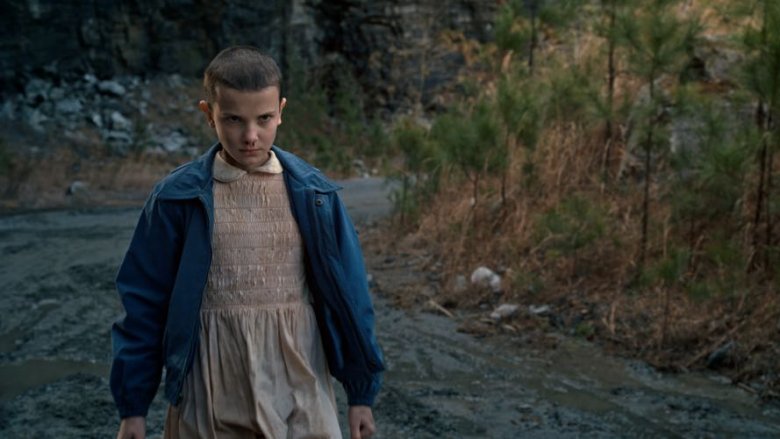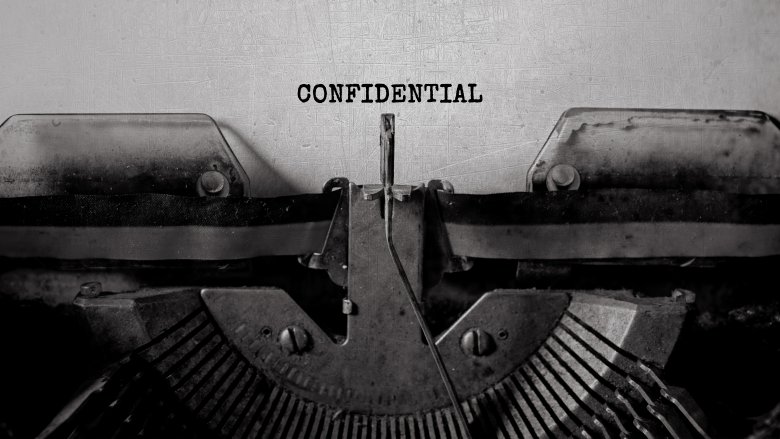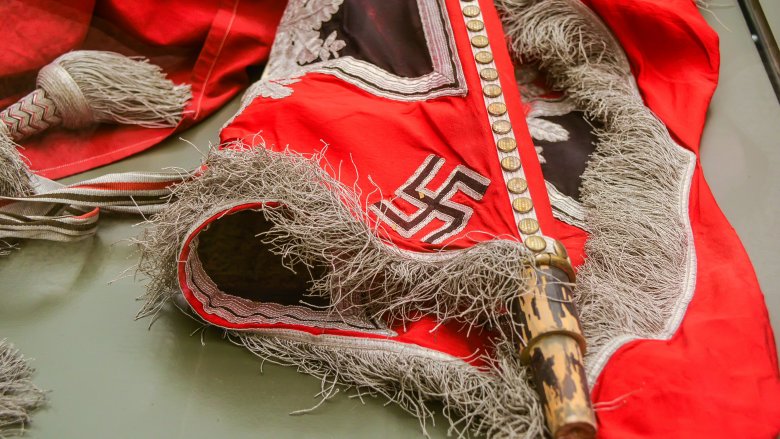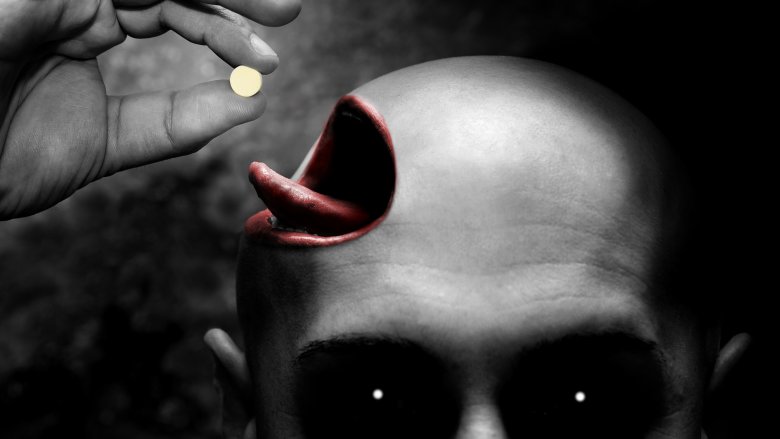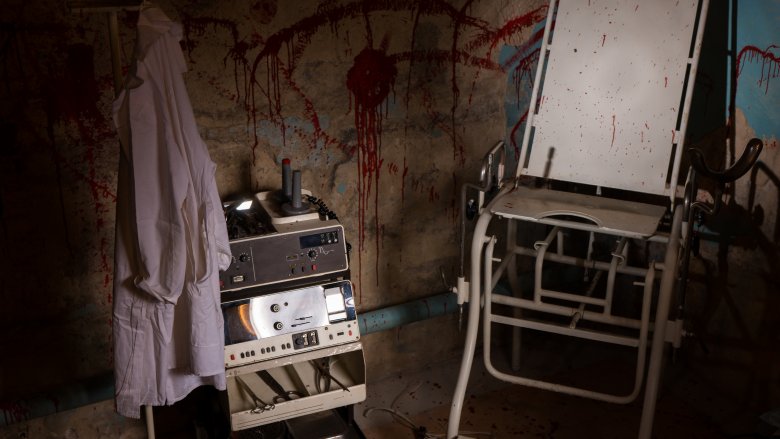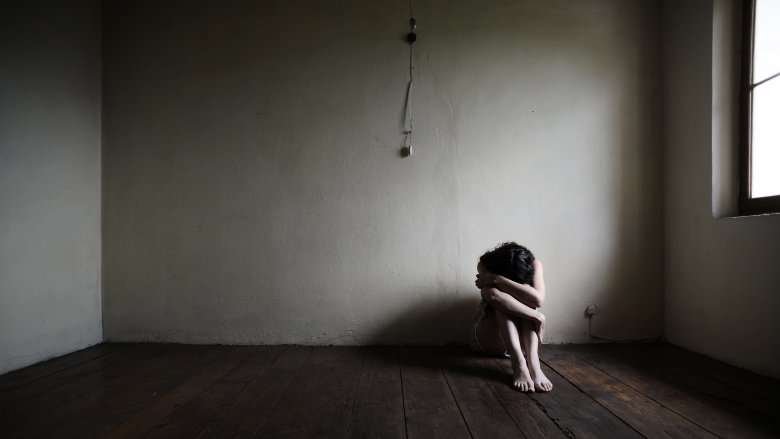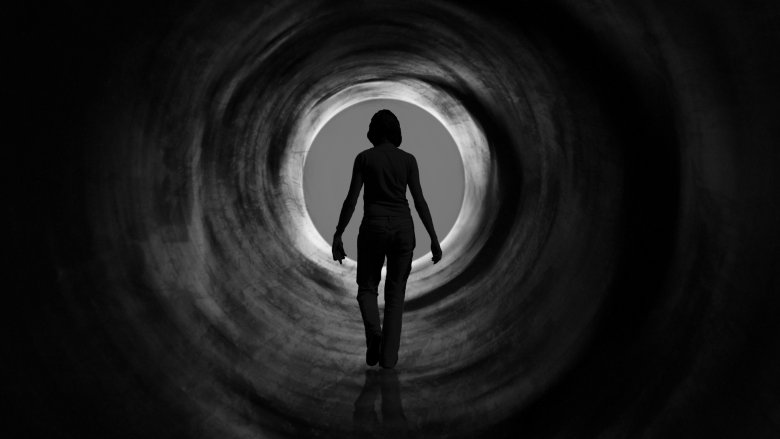The Real-Life Government Program That Inspired Stranger Things
For anyone of a certain age, the breakout Netflix hit Stranger Things wasn't just packed with nostalgia, it was a very real look into what our childhoods were like. Who didn't grow up with monsters in the closet, a perpetual game of D&D, and strange people living in the basement? Well, the last one might be a stretch, but the weird government experiments on our favorite Eggo-loving heroine are based on things that are all too real. According to what creators Matt and Ross Duffer told Rolling Stone, their inspiration came from the '80s-era movies they watched over and over, from the very real Cold War hysteria of the day, and from the government project MK-Ultra.
What were they trying to do and how far did it reach?
Finding out what went on under the umbrella of the project code-named MK-Ultra is a bit tricky. In 1977, several Senate committees held a hearing to discuss what they knew about it. Transcripts make it clear that the program stopped and Jimmy Carter's administration condemned it ... even if they didn't know what "it" was.
That's because in January 1973, then-CIA director Richard Helms ordered all MK-Ultra documents destroyed and refused to aid in any ongoing inquiries. Everything we know about MK-Ultra comes from only seven boxes of files that, according to CIA records, survived accidentally.
What they discovered is undoubtedly the tip of the iceberg. MK-Ultra got the go-ahead in 1953 and began examining how biological and chemical warfare could be used against the U.S. Fine and dandy so far. According to Gizmodo, it only took two years before "project creep" expanded goals to finding new ways to break a person physically and mentally (supposedly to better train agents and soldiers to withstand torture), produce amnesia, and find out how useful hypnosis could be. This was no small-scale government operation, either. By the time the project ended in 1964, it involved at least 86 universities, 12 hospitals, and 185 non-government researchers including specialists in narcotics and toxicology. Most civilians weren't told what their research was for. If there's ever a sign things are about to get dark, that's it.
The project's roots were in Nazi Germany
The terrible experiments done under MK-Ultra make a little more sense when you look at how the whole thing started — in the aftermath of World War II. Operation Paperclip was the U.S. program to comb through the wreckage of the Third Reich and salvage what could be saved, including some top Nazi scientists. According to The Daily Beast, bad became worse in 1948 when Swiss chemists developed LSD. It didn't take long for the CIA to wonder about the potential of weaponizing it.
At the same time, the U.S. military was teaming up with the former Surgeon General of the Third Reich, Dr. Walter Schreiber, to establish a CIA black site called Camp King. By 1948, most of the people being held there were Soviet agents, and the goal of the facility became to develop both efficient interrogation techniques and ways to help U.S. agents resist the mind-control powers the Soviets were supposedly perfecting. Don't scoff — at the time, the world had just seen the most powerful weapon ever unleashed on entire cities. War had changed, and it was about to change more.
The CIA established Project Bluebird to explore ways of combating Soviet interrogations, but that quickly escalated into using LSD as a sort of truth serum. The program was expanded into Project Artichoke with the help of Nazi scientists recruited through Operation Paperclip. Before long, MK-Ultra was born.
The LSD experiments
Since most MK-Ultra documents were destroyed, a lot of what we know comes from former test subjects who have come forward to describe what they went through, like Russell Kirk. He's a former Atlanta jail inmate who was interviewed in 1983, about 26 years after he was dosed with LSD and tried to kill himself. "I got very depressed because I knew something was wrong and I couldn't figure out what it was," he told WJLA-TV, adding that he even tried to chew through the veins in his wrists.
There are plenty of stories like that. SF Weekly looked at Operation Midnight Climax, an MK-Ultra program in the San Francisco Bay Area. Government agents paid prostitutes to serve LSD-laced cocktails to their clients, and the scenes that unfolded were recorded. Some details we know, mostly because the widow of head agent George White donated boxes of his personal items to Foothill College. White didn't just drug the guys who came into his brothel looking for a good time, either. LSD found its way into the drinks of dinner party guests, nightclub singers, and civilians hanging out on the beach. White wrote of his work, "I toiled wholeheartedly in the vineyards because it was fun, fun, fun. Where else could a red-blooded American boy lie, kill and cheat, steal, deceive, rape and pillage with the sanction and blessing of the All-Highest?"
There were plenty of non-drug related experiments, too
Dosing unsuspecting civilians and federal agents with an LSD cocktail may be the most notorious of the MK-Ultra programs, but according to the Congressional hearing on the project, there were 149 different programs running under MK-Ultra's umbrella, and not all of them involved testing drugs on clueless people. That doesn't make them less disturbing.
There were also eight projects involving hypnosis (two of which combined hypnosis and drugs), four that examined magic tricks for covert operations, nine that studied sleep and the impact of psychotherapy on human behavior, three on lie detector tests, 23 that looked at ways to motivate people and understand defectors, six on how drugs impacted a person's physical self, four on crop sabotage, and three for funding alone. There were also some one-off projects that worked with electroshock, gas-propelled sprays, and something described as "harassment techniques for offensive use."
Given what we know about MK-Ultra, it's probably a good thing their projects on concussions and how well biological agents could be absorbed through the skin got canceled early.
Many of the experiments were the brainchild of one man
His name was Sidney Gottlieb, and according to his 1999 obituary in the Chicago Tribune, he was behind pretty much every nutty idea the U.S. government came up with. He's the one who tried to kill Castro by sending him various gifts laced with poison. He also tried to kill a colonel in Iraq with a poisoned handkerchief, so you have to give the guy points for creativity. (Then take the points away for getting stale.)
Gottlieb joined the CIA in 1951, and two years later he was put in charge of MK-Ultra. According to io9, it was the perfect storm. Gottlieb's clubfoot had excluded him from military service, but he was a brilliant chemist searching for meaning in his life. He was asked to brainstorm ways to give the U.S. the edge in the Cold War. Oh, and he was an avid LSD user himself, which explains a lot.
He was the one behind Operation Midnight Climax, the dosing of prison inmates and asylum patients, and one CIA officer even described his subjects as "people who could not fight back." As if that wasn't horrible enough, there's one more awful footnote to Gottlieb's story. He retired from the CIA in 1972 (making the world a safer place) and declared MK-Ultra a dismal failure. They'd learned nothing from the program, but he was still awarded the CIA's Distinguished Intelligence Medal.
Dr. Ewen Cameron's three-step program for brainwashing
Dr. Ewen Cameron was working at the Allan Memorial Hospital in Montreal at the time he developed his three-step brainwashing program, and according to the McGill Tribune, it was classified as MK-Ultra Subproject 68. The basis was Cameron's belief people could be cured of mental illness by being "depatterned," essentially meaning their personalities needed to be completely broken apart and reassembled.
About 80 patients went through the program, which started with drugging patients into sleep lasting for days. Experiments lasted up to 86 days, according to the Alliance for Human Research Protection. This included several electroshock therapy treatments a day in order to completely break a person's mind. The doctor wrote of colleagues describing the patients as "being brought to the level of 4-year-old children ... unable to swallow but able to suck fluid from a feeding bottle," and called them "organically disorganized."
It was these broken people that would be passed into the next phase, called "psychic driving." After being given paralytic drugs but kept perfectly conscious, single messages (like, "Everyone hates me," or "My mother never loved me") would be played hundreds of thousands of times.
Needless to say, his patients suffered lifelong effects from the abuse and were later awarded $100,000 for the ordeal they suffered, according to CBC News.
What extreme sensory deprivation does to a mind
Stranger Things isn't the only work of fiction to use a saltwater-filled sensory deprivation tank to channel the powers of the human mind, and they're all drawing on some very real experiments. According to io9, neuroscientist John C. Lilly created the tanks in 1954. He wanted to see what would happen to a person's mind if all external stimuli were removed, so he outfitted people with black-out masks and put them in tanks of water the same temperature as skin. The salt in the water allowed volunteers to float with minimal effort.
Seems harmless enough, but we also have to add Lilly was no saint. He was the guy behind all the 1960s experiments to teach dolphins to talk, including the controversial one Vice reports may have included dolphin-on-girl lovin'. (That's a digression, sure, but you should know what kind of guy he was.)
Lilly used the tank himself and claimed he hooked up with an alien group called ECCO, or the Earth Coincidence Control Office. He also came across the Solid State Intelligence, which was planning to destroy earth and humankind because that's what aliens do. Most people who undergo sensory deprivation don't report aliens, but according to the BBC, they do experience terrifying hallucinations. Donald Hebb proved it in the 1950s when his sensory deprivation volunteers experienced paranoia, anxiety, and hallucinations like marching squirrels and parades of eyeglasses. That might be even worse than aliens.
Lloyd Schrier
As The Scotsman points out, there's a whole lot we don't know about MK-Ultra in general and Ewen Cameron's work specifically. Some people — including Dr. Peter Roper, who worked in the same hospital — think Cameron's reputation is just suffering from a little posthumous hate. Others, including Lloyd Schrier, think the outrage hasn't gone far enough.
His mother was pregnant with him when she went into Cameron's programs. It's not clear why she was admitted, but the case was one of a few highlighted in a Canadian Family Physician article on whether or not an unborn baby can be considered a non-consenting patient. After spending seven months in Cameron's clinic and being administered a series of barbiturates, sedatives, and electroshock therapy, she gave birth to her son in another hospital ... against all odds. Schrier says they still don't know the full story but that his mother remembered spending an entire month in the so-called "sleep room," and it was only when she was in the ninth month of her pregnancy that they refused to give her any more treatment. That's using the term "treatment" very loosely.
The death of Frank Olson
In 2012, The Telegraph reported on an MK-Ultra lawsuit filed by Frank Olson's family. We know Olson was involved with MK-Ultra from the beginning, sent to Britain to witness Ministry of Defence work regarding biological weapons and countermeasures. His family says whatever he saw there made him want out, but the CIA wasn't about to let him walk. He was dosed with LSD while at a conference, then shuffled to New York for what his family was told was "psychiatric treatment." On November 28, 1953 — nine days after he was given LSD — he fell to his death from his room in the Statler Hotel.
His death was first ruled an accident, then a suicide. His family wasn't happy with either ruling, and had him exhumed in 1996. The coroner claimed to have found signs he'd been hit in the head before his death, which was enough for his family to go after the CIA. They were also armed with supporting evidence in the form of a CIA manual specifying how a "contrived accident" involving a fall from 75 feet or higher is the most efficient technique for carrying out a "secret assassination."
There's no way this story could have a happy ending, but Olson's family didn't even get closure. The lawsuit was dismissed. A judge ruled that a previous settlement between the government and Olson's children would stand and that it was too late to pursue the case further (via RT).
MK-Search, OFTEN, and CHICKWIT
MK-Ultra was ultimately defunded, but there were several other programs that continued its work in various ways. They were touched on in the 1977 Congressional hearing on the program, and they leave more questions unanswered.
MKSearch was an official continuation of MK-Ultra, and it was given government funding from 1966 to 1972. It didn't even seem to masquerade as a defense program, clearly stated as having a very definite mission of developing covert ways to use chemical, biological, and radioactive materials "in support of highly sensitive operational requirements."
In 1967, another program run out of the Edgewood Arsenal Research Laboratories and the Office of Research and Development started looking at the effects different drugs had on human behavior. Sounds familiar, doesn't it? It was divided into two separate projects. Project OFTEN tested drugs on first animals then humans. Project CHICKWIT monitored drug and research developments overseas. Did we learn nothing the first time we went through all this?
Stargate
MK-Ultra is insane, but you can at least see where the ideas came from. For the most part, they started in real science before going off track. Stargate? Not so much.
Stargate was a CIA-funded research project run by the Stanford Research Institute (and later funded by the Defense Intelligence Agency). It started in 1972, and according to CSICOP, there were three goals: monitor other countries and their development of psychic warfare, train "remote viewers" that could work with any government agency, and explore the possibilities inherent in psychic "remote viewing."
It sounds completely kooky today, but this was at the height of the Cold War. Rumor had it the Soviets were developing the same technology, and as nutty as it might seem, there was always the possibility it might be true. The program did, indeed, train these remote viewers, even putting one into action in 1989. Angela Dellafiora and her spirits — Dr. Einstein, George, and Maurice — were asked to help find a Customs agent gone bad. Charlie Jordan had evaded authorities for too long, but Dellafiora supposedly pinpointed his location in Wyoming, near an old burial ground and a place that sounded like "Lowell." He was captured, but sources disagree on whether she had anything to do with it.
